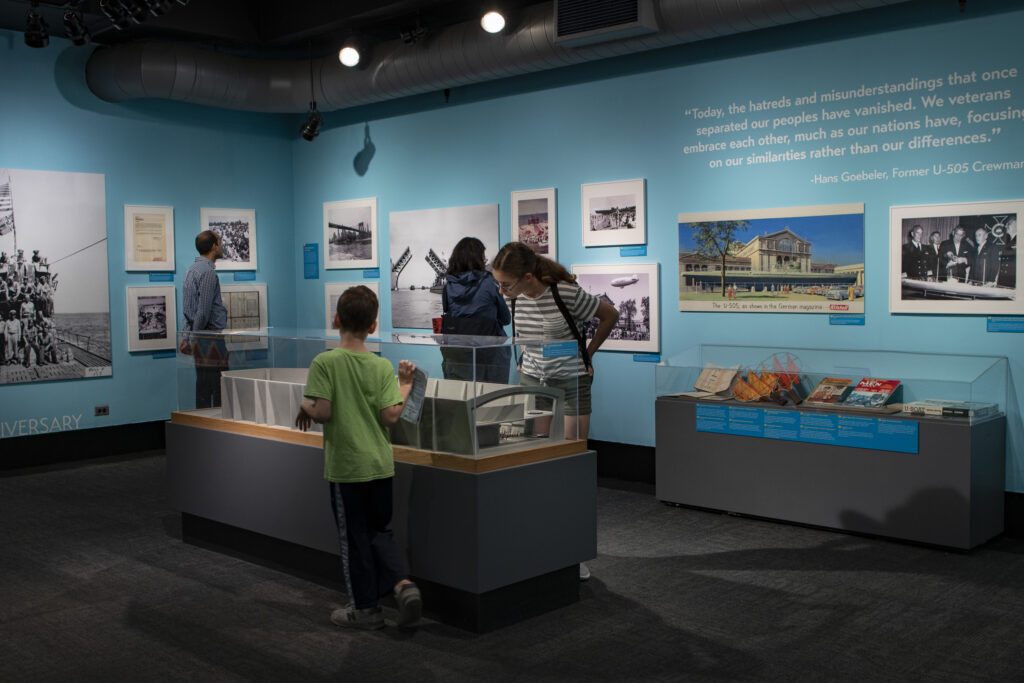The Stories They Tell
New Museum of Science and Industry exhibition humanizes the sailors who lived aboard the first submarine captured by the U.S. in World War II through the stories their personal items tell.
History is all about storytelling, conveying not only facts and figures but facets of daily life, hopes, dreams and the very ethos that surrounded an event or time of interest. These are the meat and bones of truly meaningful stories of the past, stories that not only depict ideas about a historical period or event, but those that convey the very humanity of those central to the period’s focus. One of the best ways to tell such stories is through access to a physical place, ephemera or items stemming from the period or time in question. Examining such items and spaces offers a first-hand look at how a historical subject lived, their chief concerns, their daily life and the culture in which they lived.
For over 75 years, the Museum of Science and Industry has showcased one of the most iconic spaces emerging from World War II. The famed U-505 submarine has almost a shared identity with the museum, synonymous with the museum experience, the German World War II vessel has been a mainstay for visitors there since its early installation in 1954.
But what do we know about the submarine? Seized just two days before D-Day, it was the first vessel captured by the U.S. Navy since the War of 1812, and the knowledge it held for Allies was invaluable for understanding German technology and codes, pivotal for winning the war. The 252-foot submarine was captured by the U.S.S. Guadalcanal Task Force 22.3, led by Navy Captain Daniel Gallery, a Chicago native. It’s the only U-boat of its kind (type IX-C) in the United States and one of only four left in the entire world. That gives us the fact and the figures. But what about the stories the U-boat tells. For that we have to search the vessel’s gallies and living quarters, engine room and mess areas to find elements of daily life that tell us something of the ethos that immersed German sailors on a daily basis for months on end.
In celebration of the 75th anniversary of its capture, the Museum of Science and Industry launched an extensive effort to do just that and tell the stories that the iconic submarine has held for the better part of a century, and the results were fascinating. Entitled U-505 Submarine: 75 Stories, the new exhibition was built from the museum’s vast collection and archives, and tells the U-505’s story through 75 rarely seen artifacts and photographs that offer a glimpse into daily life on the vessel and the hopes and dreams of sailors fighting within its walls.
Located in the John and Rita Canning Gallery near the museum’s main U-505 Submarine exhibit, guests will view photos of the U-505 sub, its crew and the Guadalcanal Task Force 22.3 taken out from museum archives. Guests will also view personal items, including the uniforms and journals of German and American submariners, elements of pop culture, inspired by the U-boat’s capture like a board game and comic book celebrating the actions of Captain Gallery, the Chicagoan who led the capture.
Also on display are U-505 conservators’ tools used during the nearly two-year long conservation effort undertaken through the support of a National Maritime Grant.
The extensive research done in this project help to illuminate life in key areas of the sub like the control room, galley kitchen, conning tower and aft torpedo room, which was restored historically with accurate paint colors and materials after years of wear and tear. Because of these conservation efforts, guests will have an even more realistic sense of a submariner’s life onboard the sub during WWII. Outside of the sub, guests can see the life raft that was used to carry the German sailors from the sinking vessel to American ships, re-inflated and on display.
Why was it so important that curators take such a deep dive into life on this more than 75-year-old World War II vessel? It’s simple: humanity. Dr. Voula Saridakis, a curator at the Museum of Science and Industry, explained that examination of the photos, artifacts and labels on view in the exhibition helps to tell a more human story of what life was like aboard this cramped submarine at the center of one of the most important war-time captures in our nation’s history. “There was limited movement, limited fresh water and the overall dangers of being at sea sometimes for months on end,” Dr. Saridakis explained. “The exhibit also explores the kinds of activities the sailors engaged in that brought a deeper sense of camaraderie among the men who had to rely on each other to survive.”
From this perspective, we get a better sense of the humanness of the submariners working on the front lines of the German war effort.
On view in the exhibition is a personal diary of a U-505 crewman that details the tight living spaces aboard. It detailed a myriad of insights from the unbearable heat to hopes of a coming return home. There is a scrapbook of German naval correspondent Werner Tiemans, who offered a detailed description of his experiences while stationed with the U-boat fleet. Guests can also view a telegram to the USS Pillsbury from the secretary of the Navy on May 8, 1945 announcing the end of the war.
These ephemera all offer insight into the day-to-day workings on the submarine, like the wooden plan replicas, which were replaced on the conning tower of the submarine, fashioned to look like the originals. Dr. Saridakis explained that these planks were placed along the metal area in the center of the tower atop the sub, where sailors could lean. But why wooden planks? They simply made the metal surfaces warmer and less slippery. Dr. Saridakis noted that these kinds of intricate details help to illuminate daily challenges with which sailors aboard the U-505 and other submarines like it had to grapple, challenges we rarely consider. “It’s little details like this you don’t think about until someone explains it to you,” Dr. Saridakis told me. “And then you have this aha moment.”
U-505 Submarine: 75 Stories is replete with aha moments just like this. They give a humanizing effect to the heretofore distant “enemy” combatant that inhabited this iconic vessel, and in doing so, they help us to come to better understand their journey and their story.
Many guests of the exhibition will be intrigued to learn more about Captain Dan Gallery. Captain of the USS Guadalcanal (the carrier of Task Force 22.3, the lead ship of the task force that captured the U-505), Gallery put into place a plan to capture a U-boat and had already prepared crew for landing parties, should the eventuality presented itself.
When the U-505 was spotted running the surface off the coast of Africa in 1944, Captain Gallery pounced. For capturing the U-505, Task Group 22.3 was awarded the Presidential Unit Citation, and Gallery, the Distinguished Service Medal. But that service medal could have easily been a court-marshall. As pointed out to Gallery, in not so pleasant terms, by Admiral Ernest J. King, Chief of Naval Operations in 1944, unless word of U-505’s capture could be kept under wraps, the Germans would certainly change their codes and the cipher wheels on their encryption device, Enigma. Captain Gallery’s success was as much about maintaining that silence about the U-boat’s capture as it was about the capture itself.
As a compliment to the U-505 Submarine exhibition, which offers guests a chance to walk through areas of the famed submarine within the halls of the museum, U-505 Submarine: 75 Stories takes us deeper into the daily lives of the sailors who inhabited the vessel for months until its capture in 1944, and in doing so, it offers a chance to understand what life was like for sailors aboard all U-boats during that era, which according to Dr. Saridakis, was no walk in the park. “These submariners lived in uncomfortable quarters, but tried to keep comfortable and keep morale up through activities that might seem routine like eating three meals a day, playing cards or listening to music,” Dr. Saridakis told me. “Guests will also learn that the sailors did whatever was necessary to survive, including repairing the U-boat while at sea after heavy damage by an English bomber, that water was limited so it had to be rationed, and that sailors would ‘hot bunk’ which means taking turns sleeping on the limited number of bunks that were folded up and moved out of the way when necessary.”
For the viewer of this exhibition, and the original from which it sprang, these kinds of connections made from the artifacts and objects found aboard can go a long way toward helping to add color to our perspective of the iconic U-boat we’ve come to know over the years, telling the stories of the sailors who called it home for a time, and those who plucked it out of history, placing it in the coffers of the Museum of Science and Industry and helping to win World War II in the process.
U-505 Submarine: 75 Stories is currently on view at the Museum of Science and Industry. Admission is included with admission to the museum.




